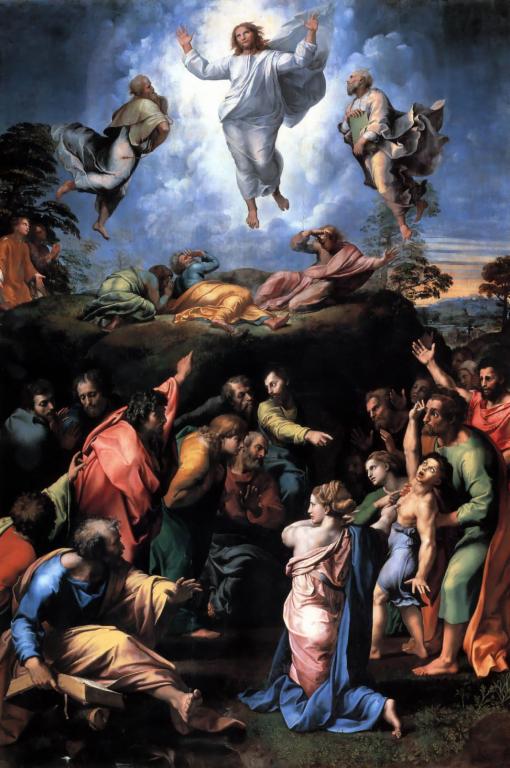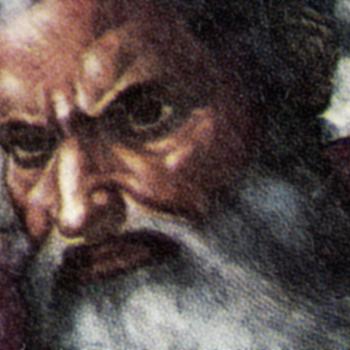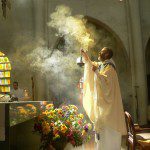
Our journey through Lent continues with my experiment in Lectio Divina Diligens. Click on the link to read about this idea, if you’re not familiar with it.
Today let’s look at the readings for the Second Sunday in Lent, particularly the Gospel Reading, Mark 9:2-10. It’s the story of the Transfiguration.
Lectio — reading
After six days Jesus took Peter, James, and John and led them up a high mountain apart by themselves. And he was transfigured before them, and his clothes became dazzling white, such as no fuller on earth could bleach them. Then Elijah appeared to them along with Moses, and they were conversing with Jesus. Then Peter said to Jesus in reply, “Rabbi, it is good that we are here! Let us make three tents: one for you, one for Moses, and one for Elijah.” He hardly knew what to say, they were so terrified. Then a cloud came, casting a shadow over them; then from the cloud came a voice, “This is my beloved Son. Listen to him.” Suddenly, looking around, they no longer saw anyone but Jesus alone with them.
As they were coming down from the mountain, he charged them not to relate what they had seen to anyone, except when the Son of Man had risen from the dead. So they kept the matter to themselves, questioning what rising from the dead meant.
Investigatio — research
On the first Sunday of Lent we follow Jesus into the desert, for his forty day fast/vision quest — culminating in the three-fold temptation Jesus experiences (and overcomes, thanks to his reliance on the Word of God rather than the beguiles of his tempter).
This week our reading is no less dramatic, but not quite as conflict-driven. We move from the desert to the mountaintop, where Jesus, accompanied by his close friends/inner circle of Peter, James and John, undergoes the Transfiguration.
Verbum (the application I use for Bible study and scripture commentary) offers a number of ways to learn more about this powerful but enigmatic passage. Today I’m going to look at what scripture scholar N.T. Wright has to say about the passage, quoting from his book Mark for Everyone:
What was the inner reality of Jesus’ work? He was continuing and completing the tasks of the great prophet Elijah, and, behind him, of the greatest prophet of old, Moses himself… Now they reappear, with the veil of ordinariness drawn back for a moment, and Jesus is with them, shining with a brilliant light.
People are often fuzzy about what this means. It isn’t a revelation of Jesus’ divinity; if it were, that would make Elijah and Moses divine too, which Mark certainly doesn’t want us to think. Once again, Mark believes in Jesus’ divinity, but hasn’t yet told us why. Rather… this is a sign of Jesus being entirely caught up with, bathed in, the love, power and kingdom of God, so that it transforms his whole being with light, in the way that music transforms words that are sung. This is the sign that Jesus is not just indulging in fantasies about God’s kingdom, but that he is speaking and doing the truth. It’s the sign that he is indeed the true prophet, the true Messiah.
Try to avoid the temptation to think about this story “scientifically.” How did the prophets appear? What caused the light to shine? These kinds of questions miss the point. Read this story for its spiritual message: in the words of the Collegeville Bible Commentary, “When [the disciples] see him conversing with Elijah and Moses, they are awe-struck at the realization that Jesus is the fulfillment of the prophets (Elijah) and of all the law (Moses).”
Meditatio — reflection
I love the painting of the Transfiguration by Raphael, where all the disciples are shown — most of them at the bottom of the mountain, but the three who accompanied Jesus to the mountaintop are also seen, reclining in wonder (or fear). Meanwhile, Christ appears to be levitating, between and slightly above Moses and Elijah, who gaze at him in rapt awe. If Moses symbolizes “law” and Elijah “prophecy,” then this image makes clear that both of these essential currents of Old Testament spirituality are united and fulfilled in Christ. Christ is the new law — the one who brings structure and order to the universe. Christ is also the culmination of the prophets, those who speaks God’s word of liberation and salvation.
Human nature being what it is, it seems to me that many people tend to prefer either a structured approach to life or a free-wheeling approach. Some of us want a clear-cut, black-and-white, by-the-book way of doing things — even faith. These are the “Moses” people. Others want to emphasize not the rules but the exceptions, not limitations but possibilities, and feel that tradition should never trump innovation. These are the “Elijah” people.
The Transfiguration calls us out of our comfort zones — which ones we may inhabit — to recognize that Christ represents the fulfillment of both law and art, both tradition and prophecy, both structure and liberty. This may sound paradoxical, but remember what Colossians says: “in him all things hold together.” (Colossians 1:17)
Join with me and reflect on Moses and Elijah. Which one do you feel more comfortable with? What does it mean to suggest that in Christ, both the law and the prophets will find union and integration? How can play out in your life?
Oratio — response
God, you have created us in your image and likeness. You have said that we are the light of the world, just as you are the light of the world. Let your light shine through us. Teach us to embody both your life-giving law and your vast, loving, prophetic liberation. Help us to find you in the mountaintop moments just as surely as we seek you in the desert. With confidence in the name of Christ we pray. Amen.
Contemplatio — rest
Please join with me at a time that is appropriate for you, to simply rest in the silent presence of God, knowing that God loves you and me and all creation — whether we can feel it or not.
This is the third of a series of Lenten devotional posts, written in a spirit of Lectio Divina Diligens — lectio divina (sacred, meditative reading) combined with a contemplative, “diligent” approach to scriptural interpretation. Research into the interpretation of scripture is performed using Verbum.
Enjoy reading this blog?
Click here to become a patron.














